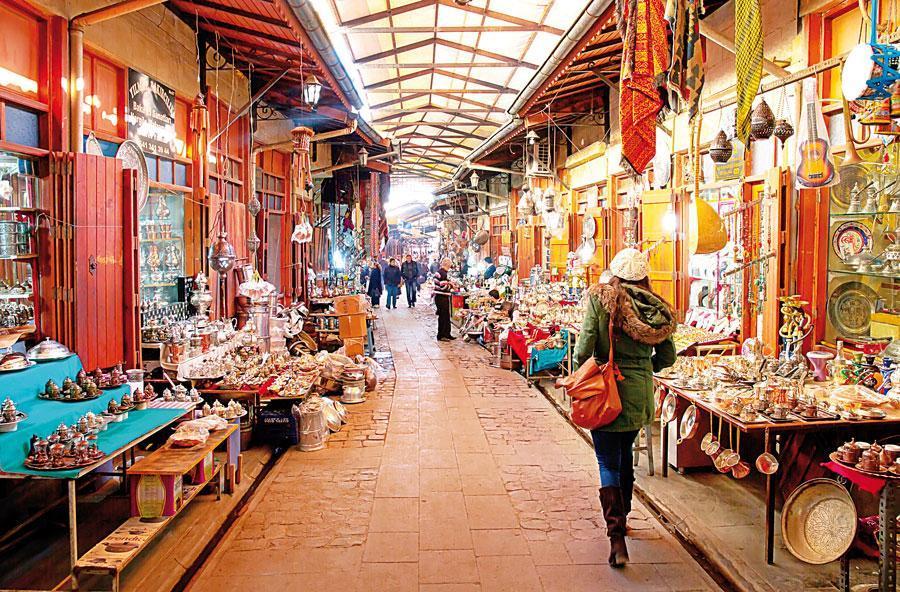
Kebab shops, pastry makers, liver sellers and, of course, baklava sellers seem to be in a competition to whet visitors’ appetites. Walking on the narrow, meandering streets of the city that covers its worn-out appearance with a new face, makes one feel like solving a puzzle step by step.
Gaziantep, known as Doliche in the Antique Age, is one of the oldest settlements in the world, according to numerous sources. The city that hosted countless civilizations from Commagene to Byzantine has been under Turkish rule since 11th century. It received the “Gazi” (Veteran) title for the battle fought against enemy occupation in the years of the Turkish War of Independence.
The Antep Castle, atop the city’s highest hill Kudret Rock, has preserved its glory since the Hittites. The tunnel in the castle that resembles the entrances of Roman amphitheaters, battle and observation terraces offering a 360-degree city panorama, the ruins of mosques, and baths dating back to the Ottoman era are worth seeing. One must visit the Şahinbey neighborhood to observe the finest examples of local houses. High stone walls of houses lined along narrow alleyways were built to protect residents from the scorching summer heat.

There is as much history below the city as there is above. There are tunnels called “cave” in the oldest houses. Researchers liken Gaziantep’s underground to a massive ant nest.
Through inns
Streets stretching out among kebab houses at every step, baklava places and shops that sell textiles and fabrics with local patterns open to historical Uzun (Long) Bazaar famous for its coppersmiths and spice stores. It is not difficult to come across shops which offer the best variety of Antep kebabs in the vicinity. Ali Nazik kebab served on aubergine puree, şöbiyet pastry, keme mushrooms, küşleme (back meat of sheep) and many more.
After Uzun Bazaar, the mother of pearl workshops comes next in line. The Archaeology Museum, where mosaics and archaeological artifacts unearthed in Zeugma and near archaeological sites are exhibited, is one of Gaziantep’s most exciting corners. Gaziantep is the city of old and elegant mosques as well.
Some of the historical mosques in the city are Ömeriye, the oldest mosque, Boyacı which has a minaret with a wooden roof and a pulpit carved from rosewood, Tekke where Mevlevi dervishes sought enlightenment once, and Kurtuluş with its magnificent stone-masonry and minarets built over the bell tower. Gaziantep which has been a trade center throughout history appears as a city of bazaars and inns and that befits its dignity. You must visit some of the inns, such as Kürkçü (Fur-maker) Inn, Tuz (Salt) Inn, Mecidiye Inn, and Şıra Inn which will surely make their presence felt as you tour the city. For those who would like to make their Gaziantep itinerary richer with excursions, Doliche Ruins and Underground Sepulchers, Belkıs-Zeugma and Rumkale are the ideal destinations.

Spice-scented streets
Autumn months find people retreating from streets to homes in a colorful rush in Antep, because women go beyond the daily rush of their households and participate in an incredible production process. In the wee hours of the day, pistachio cracking sounds rise from houses in İnönü neighborhood, a sharp odor of hot peppers emanate from the Demirligane and Perilikaya neighborhoods, bell peppers and aubergines are dried on the terraces called “summerly,” churchkelas are dipped into massive cauldrons in Savcı neighborhood, and it is all their work. Is it easy? This is a region where dining is regarded a life-style. And it is almost always kebab time. It is customary to first eat beyran (Rice with soup) at five in the morning, with eating and drinking continuing till midnight with katmer pastry, yuvalama (soup with meatballs) and baklava. It is an Antep classic to stop by at the 100-year-old Tahmis coffeehouse and have a foamy Turkish coffee accompanied by an orchestra called “Cümbüş (Jollity).”
According to the writer Ahmet Ümit from Gaziantep, the local cuisine, which is diversified thanks to the contributions of various cultures, gives an idea on how the table in paradise might be. You might agree with the famous writer on trying Antep’s delicacies.
Bazaar within a bazaar
An export leader of the southeastern Anatolia region with its developed industry and a population reaching up to two million, Gaziantep aims to become Anatolia’s tourism capital. Thousands of people are employed in nearly 20 hotels built for this purpose. According to journalist Coşkun Aral, Gaziantep might exceed the goal of attracting a million tourists yearly by diversifying its tourism.

Indeed there are innumerable attractions to amaze one in this city which gradually transforms into a museum city: Turkey’s first glass-work museum Medusa where you can see 4000-year-old toys, is just one. In addition, a planetarium science center, a fairy tale park, botanical garden and ecological city projects are some elements demonstrating city’s tourism potential. A 5.5-kilometer-long culture route, which takes the Gaziantep Castle as its center, is a new asset for the city. Walking on the serpentine streets where a total of 19 inns, nine mosques and four bathhouses, including the Ali Nacar Mosque, Naib Bath House, Gümrük Inn, Zincirli Bedesten, Tahmis Coffeehouse, Almacı Bazaar and Bakırcılar (Coppersmiths) Bazaar, are lined up, is like gliding through layers of history.
The city’s face is changing with the restoration of around 500 houses and mansions on the culture route and more than 1000 shops. On this culture road, which also functions as a shopping route, authentic handicrafts such as yemeni-making (flat-heeled shoe), copper-working, mother of pearl-inlaying and kutnu fabric-weaving are survived. The city, an utterly dynamic trade center from the past to present, resembles a huge open-air bazaar.
As historical inns are lined one after the other, bazaars are intertwined. Where else can one witness how kutnu fabric, survived as a handicraft and referred to as “Like Gold” in the song written by Kerem for his lover Aslı, is weaved fiber by fiber in bright colors?